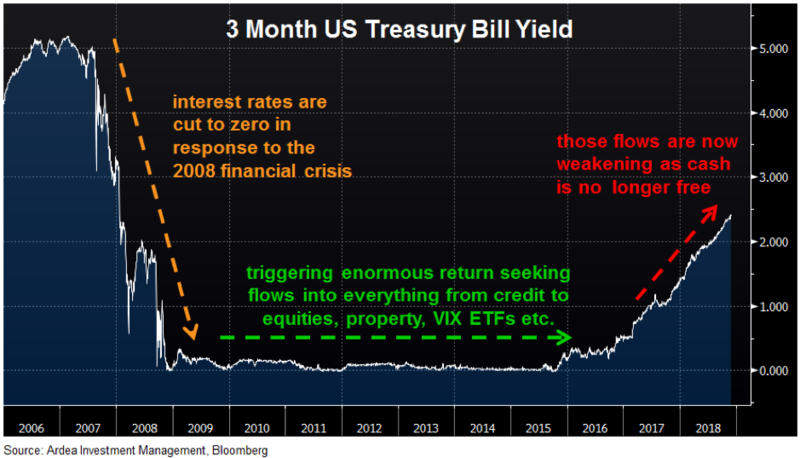Interest rates matter … a lot

Even if you have no exposure to fixed income, interest rates still matter … a lot.
Having minimal credit or interest rate risk (politics aside), the interest rate on very short dated US government bonds, referred to as Treasury Bills (or T Bills), can be used as a proxy for a risk free rate of return. In response to the 2008 financial crisis, central banks around the world cut interest rates and embarked on an unprecedented program of monetary stimulus. As a result, risk free rates around the world fell to zero. This had two related effects:
1. Asset prices pushed higher
Risk free rates form the foundation from which all discount rates are calculated. These discount rates are then used to value cash flows generated by assets ranging from bonds to stocks to real estate. As discount rates fell, the valuation of cash flows rose and therefore asset prices were pushed higher.
2. The reach for yield
Secondly, as the rate of return investors could get from lower risk assets fell in line with risk free rates, a great rotation of capital began that has lasted for the past ten years. A wall of money progressively moved up the risk spectrum, into riskier and riskier assets, in order to generate higher returns … the so called ‘reach for yield’.
In fixed income this manifested as capital rotating out of cash deposits and government bonds into progressively riskier credit securities. More broadly, capital poured into everything from equities to emerging markets, property, VIX ETFs etc. … basically anything that offered a return above zero. This was a paradigm in which the desperate search for returns trumped considerations of how much risk was being taken to earn those returns. As risk free rates are now rising, the paradigm has changed. Cash is no longer free and those return seeking flows have correspondingly weakened. In July this year, the yield on 3 month US T Bills broke above 2%, and have since gone even higher. As the chart shows, this is a big change from the free money world investors had become accustomed to in the post financial crisis era, with more than half of that move higher happening in just the past 10 months. It’s not a coincidence that equities and pretty much all other asset classes have struggled over this period.
What does it tell us?
1. Firstly, the discount rate applied to all financial asset valuations is now rising and therefore, all else equal, asset prices should become more vulnerable.
2. Secondly, you can now earn 2.4% from risk free 3 month T Bills at a time when riskier assets are offering much smaller return pick-ups than they used to. This naturally means the compulsion to keep stretching risk budgets in the search for higher returns is no longer as strong and the risk vs. reward proposition of continuing to reach for yield is now much less appealing.
This doesn’t mean all capital flows suddenly reverse into lower risk assets. Rather, it’s subtle at first, like water leaving a bath tub when the plug is removed. Initially you hardly notice but then it becomes increasingly obvious the water is running out. We’re already seeing some evidence of this, for example in accelerating outflows from even ‘safe’ investment grade credit assets. This dynamic has negative implications for asset price valuations and volatility across all financial markets. So far 2018 has only given us a small taste of this … we expect much more going forward.
These insights were featured in a recent Livewire Exclusive article. Click here to read the full article.

